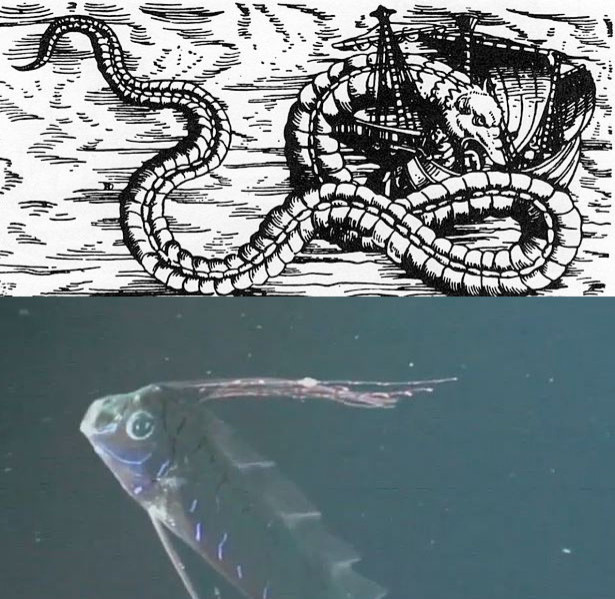Underwater UFO? Sea Serpent? Nope, Just An 8-Foot-Long Oarfish [VIDEO]

Scientists have caught a glimpse of a serpent-like creature lurking about 200 feet below the surface of the Atlantic Ocean. But the 8-foot long creature isn’t a young sea serpent or a cousin of the Loch Ness monster; it’s an oarfish.
(There are good close-up shots of the fish starting around the five-minute mark.)
Louisiana State University marine biologist Mark Benfield and his colleagues captured this video of an 8-foot-long giant oarfish. The rarely seen creature, which belongs to a species officially known as Regalecus glesne and sometimes informally known as the “king of herrings,” has bright-blue iridescent markings and a long dorsal fin stretching from the back of its head.
Unlike more-familiar fish, the oarfish tends to hang around in the water vertically, with its head pointed toward the surface. This orientation allows the oarfish to easily scan the water above it, looking for tiny crustaceans to munch on. Vertical orientation also likely makes the oarfish less noticeable to predators below.
"The striking thing is they swim by undulating their dorsal fin like a propeller, and they can change direction instantly," Benfield told the Los Angeles Times. "Most of the time they move slowly and stealthily, but when they want to, they can move fast."
Benfield and his colleagues published the video and other observations – including one sighting of a giant oarfish at a depth of about 1,600 feet -- last week in the Journal of Fish Biology. The video of the oarfish was captured by a remotely operated vehicle, or ROV, in August 2011. Benfield and his team have worked out a deal with oil companies in the Gulf of Mexico and elsewhere to use some of their ROVs, normally used to prospect for oil, to search for deep-sea life.
Mistaken Identities?

As eerie and impressive as the oarfish shown in the new video is, it’s a bit of a small fry compared to other members of R. glesne, some specimens of which have measured 36 feet long and weighed up to 200 pounds. Given the oarfish’s serpent-like shape and undulating swimming motion, it’s easy to imagine how one venturing closer to the surface (or washing up on a beach) might have inspired tales of sea serpents.

Other sea creatures have been mistakenly identified as mythological monsters. Centuries ago, manatees, dugongs and sea cows were often confused as mermaids from afar -- even Christopher Columbus made that mistake, noting that the mermaids he saw were “not half as beautiful as they are painted.”

Another case of mistaken identity in centuries past involved the narwhal. The spiraling tusk of the narwhal (actually a modified tooth that acts as a sensory organ), was often passed off as a unicorn horn and sold for a small fortune.
SOURCE: Benfield et al. “Five in situ observations of live oarfish Regalecus glesne (Regalecidae) by remotely operated vehicles in the oceanic waters of the northern Gulf of Mexico.” Journal of Fish Biology published online 5 June 2013.
© Copyright IBTimes 2024. All rights reserved.











